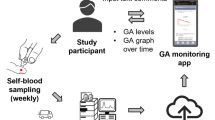Abstract
The purpose of this study was to evaluate the accuracy of a mobile wireless digital automatic blood pressure monitor for clinical use and mobile health (mHealth). In this study, a manual sphygmomanometer and a digital blood pressure monitor were tested in 100 participants in a repetitive and sequential manner to measure blood pressure. The guidelines for measurement used the Korea Food & Drug Administration protocol, which reflects international standards, such as the American National Standard Institution/Association for the Advancement of Medical Instrumentation SP 10: 1992 and the British Hypertension Society protocol. Measurements were generally consistent across observers according to the measured mean ± SD, which ranged in 0.1 ± 2.6 mmHg for systolic blood pressure (SBP) and 0.5 ± 2.2 mmHg for diastolic blood pressure (DBP). For the device and the observer, the difference in average blood pressure (mean ± SD) was 2.3 ± 4.7 mmHg for SBP and 2.0 ± 4.2 mmHg for DBP. The SBP and DBP measured in this study showed accurate measurements that satisfied all criteria, including an average difference that did not exceed 5 mmHg and a standard deviation that did not exceed 8 mmHg. The mobile wireless digital blood pressure monitor has the potential for clinical use and managing one’s own health.

Similar content being viewed by others
References
Uhlig K, Patel K, Ip S, Kitsios GD, Balk EM. Self-measured blood pressure monitoring in the management of hypertensiona systematic review and meta-analysis. Ann Intern Med. 2013;159(3):185–94.
Danaei G, Lu Y, Singh GM, Carnahan E, Stevens GA, Cowan MJ, et al. Cardiovascular disease, chronic kidney disease, and diabetes mortality burden of cardiometabolic risk factors from 1980 to 2010: a comparative risk assessment. Lancet Diabetes Endocrinol. 2014;2(8):634–47.
Committee G. 2003 European Society of Hypertension-European Society of Cardiology guidelines for the management of arterial hypertension. J Hypertens. 2003;21(6):1011–53.
Mancia G, De Backer G, Dominiczak A, Cifkova R, Fagard R, Germano G, et al. 2007 ESH-ESC practice guidelines for the management of arterial hypertension: ESH-ESC task force on the management of arterial hypertension. J Hypertens. 2007;25(9):1751–62.
Celler BG, Le P, Basilakis J, Ambikairajah E. Improving the quality and accuracy of non-invasive blood pressure measurement by visual inspection and automated signal processing of the Korotkoff sounds. Physiol Meas. 2017;38(6):1006.
Kakkad KM, Damor P, Parmar B, Patel S, Prajapati V, Dhivar N. Comparative study of blood pressure measurement by aneroid and digital manual sphygmomanometer. Natl J Community Med. 2016;7(8):700–2.
Meidert AS, Saugel B. Techniques for noninvasive monitoring of arterial blood pressure. Front Med. 2017;4:231.
Association for the Advancement of Medical Instrumentation. American national standard for electronic or automated sphygmomanometers. Arlington, Virginia: 1992. Report No.
O’Brien E, Petrie J, Littler W, de Swiet M, Padfield PL, Altman DG, Bland M, Atkins N. The British Hypertension Society protocol for the evaluation of blood pressure measuring devices. J Hypertens. 1993;11(suppl 2):S43–62.
Hertzman AB. Observations on the finger volume pulse recorded photoelectrically. Am J Physiol. 1937;119:334–5.
Shelley KH. Photoplethysmography: beyond the calculation of arterial oxygen saturation and heart rate. Anesth Analg. 2007;105(6):S31–6.
Medaval. The Standard for Medical Device Evaluation. Blood pressure monitors for home use. http://www.medaval.org/. Accessed 21 June 2018.
Parati G, Asmar R, Stergiou GS. Self blood pressure monitoring at home by wrist devices: a reliable approach? J Hypertens. 2002;20(4):573–8.
Acknowledgements
This work was funded by SK Telecom Co. Ltd and supported by the Technology Innovation Program funded By the Ministry of Trade, Industry and Energy (MOTIE) of Korea (10049785, Development of ‘medical equipment using (ionizing or non-ionizing) radiation’-dedicated R&D platform and medical device technology). The authors thank the Medical Research Collaborating Center at Seoul National University Bundang Hospital for consultation on the statistical analyses.
Author information
Authors and Affiliations
Corresponding author
Ethics declarations
Conflicts of interest
There are no conflicts of interest. This work was supported by SK Telecom Co. Ltd.
Ethical statement
This study was funded by SK Telecom Co. Ltd. All procedures performed in studies involving human participants were in accordance with the ethical standards of the institutional research committee and with the Helsinki declaration and its later amendments or comparable ethical standards. Informed consent was obtained from all individual participants included in the study.
Rights and permissions
About this article
Cite this article
Yoo, S., Baek, H., Doh, K. et al. Validation of the mobile wireless digital automatic blood pressure monitor using the cuff pressure oscillometric method, for clinical use and self-management, according to international protocols. Biomed. Eng. Lett. 8, 399–404 (2018). https://doi.org/10.1007/s13534-018-0085-0
Received:
Revised:
Accepted:
Published:
Issue Date:
DOI: https://doi.org/10.1007/s13534-018-0085-0




